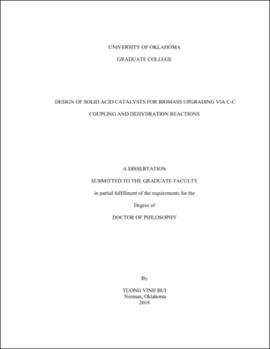| dc.description.abstract | Furanics fraction has been a major obstacle that impedes the feasibility of practical upgrading of bio-oil. The high reactivity of species existing in the mixture favors humins formation via polymerization. This leads to rapid catalyst deactivation and carbon loss. Via the Piancatelli ring rearrangement, furfural, one of the most abundant species found in the second-stage of biomass torrefraction, can be stabilized into cyclopentanone (CPO) which can be used as a potential building block for C-C coupling reaction.
This work covers two main sections. In the first part, different propitious upgrading strategies, focusing on using CPO as the building block for C-C coupling reactions (hydroxylalkylation, aldol condensation and alkylation) with other available oxygenates existing in a bio-oil mixture have been investigated. For example, via aldol condensation/hydroxyalkylation pathway and a following hydrodeoxygenation step, a mixture of C7-C16 saturated hydrocarbons, which are in the gasoline/diesel range can be effectively produced. Over 90% efficiency of the whole catalytic upgrading process starting from CPO has been demonstrated, which highlights the potential of this strategy for future biofuel applications. Along with the practical investigations, fundamental studies have also been conducted to give some extensive insights into the reaction mechanisms, active site requirements as well as the effects of water, a commonly found impurity in biomass conversion, to the catalytic activity and the stability of the catalysts.
The second section mainly focuses on designing suitable solid acid catalysts that could be applied for the bio-oil upgrading processes. The catalysts have to satisfy several requirements including high activity, stability and resistance against deactivation in harsh chemical environments (high temperature, high water content, polar solvent, etc.). The results have shown that zeolites and mesoporous silica are susceptible to the water/polar species attack, caused by the presence of surface silanols. This results in rapid deactivation and structure collapse. The effective way to improve hydrothermal stability of the catalysts is to reduce the density of surface silanols via functionalization with organic-functional groups which could increases the surface hydrophobicity and protect the surface from water | en_US |
